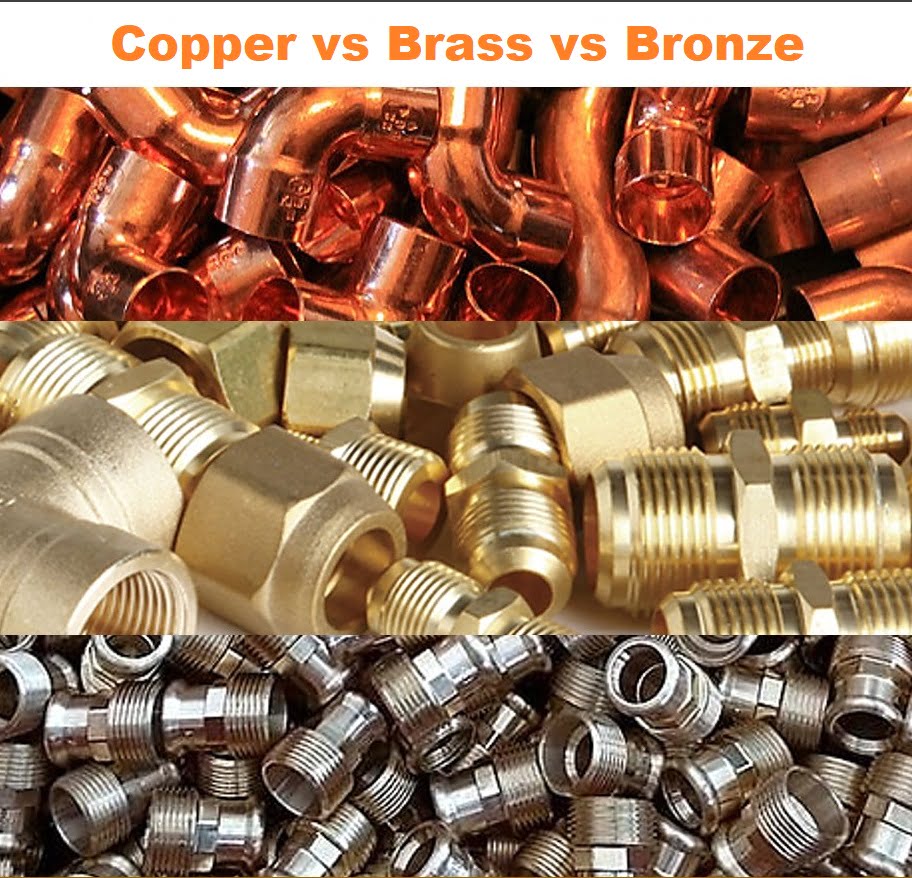Copper vs. Brass vs. Bronze: A Comprehensive Comparison

Copper, brass, and bronze are three of the most important and widely used metals in various applications, from construction to electronics. Each of these alloys possesses unique properties and characteristics that make them suitable for specific uses. Understanding the differences among these metals can aid in selecting the right material for your project. This article explores the composition, properties, advantages, and common applications of copper, brass, and bronze.
1. Composition
Cobre
- Chemical Symbol: Cu
- Composição: Copper is a pure metal with the atomic number 29.
- Common Alloys: Copper is often alloyed with elements like zinc, tin, or nickel to create different copper alloys.
Latão
- Chemical Symbol: CuZn
- Composição: Brass is primarily an alloy of copper (typically 55-95%) and zinc (5-45%).
- Common Alloys: Other elements such as lead, tin, or aluminum may be added to enhance specific properties like machinability or corrosion resistance.
Bronze
- Chemical Symbol: CuSn
- Composição: Bronze is primarily an alloy of copper and tin (around 60-90% copper and 10-40% tin).
- Common Alloys: Other elements, including aluminum, manganese, or phosphorus, can be included to improve specific characteristics.
2. Properties
Cobre
- Color: Reddish-brown hue.
- Condutividade: Excellent electrical and thermal conductivity.
- Resistência à corrosão: Good resistance to corrosion, particularly in marine environments.
- Ductilidade: Highly ductile and malleable, allowing for extensive shaping and forming.
- Força: Strong, but not as strong as its alloys.
Latão
- Color: Yellowish-gold appearance.
- Condutividade: Good electrical conductivity, though not as high as pure copper.
- Resistência à corrosão: Moderate resistance to corrosion; can develop a patina.
- Ductilidade: Offers good ductility, but varies depending on the zinc content.
- Força: Generally stronger than pure copper, especially in high-zinc alloys.
Bronze
- Color: Reddish-brown or gold-tinted appearance.
- Condutividade: Good electrical conductivity, but lower than copper and brass.
- Resistência à corrosão: Excellent corrosion resistance, especially in seawater; does not tarnish as easily as brass.
- Ductilidade: Fair ductility, though not as much as copper.
- Força: Typically stronger and harder than copper and brass, particularly in high-tin alloys.
3. Advantages
Advantages of Copper
- Condutividade: Ideal for electrical applications due to high conductivity.
- Resistência à corrosão: Effective in environments where corrosion is a concern.
- Maleabilidade: Easily shaped into various forms, making it versatile for manufacturing.
- Recyclability: Highly recyclable without loss of properties.
Advantages of Brass
- Maquinabilidade: Easier to machine than copper due to its softer nature.
- Apelo estético: Attractive appearance, often used in decorative applications.
- Anti-Bacterial Properties: Natural resistance to bacteria, making it suitable for plumbing and fittings.
- Versatility: Available in many grades and can be tailored for specific applications.
Advantages of Bronze
- Durabilidade: Excellent strength and resistance to wear make it suitable for heavy-duty applications.
- Resistência à corrosão: Outstanding performance in marine environments, ideal for shipbuilding and coastal applications.
- Low Friction: Lower friction properties make it suitable for bearings and bushings.
- Não-faísca: Safe for use in explosive environments.
4. Common Applications
Applications of Copper
- Electrical Wiring: Widely used in electrical systems due to its excellent conductivity.
- Encanamento: Commonly used for pipes and fittings because of corrosion resistance.
- Eletrônica: Utilized in circuit boards and connectors.
- Roofing: Used in architectural applications for its aesthetic appeal and durability.
Applications of Brass
- Musical Instruments: Commonly used for brass instruments due to its acoustic properties.
- Fittings and Valves: Used in plumbing and heating applications for its machinability.
- Decorative Items: Frequently employed in decorative hardware and jewelry.
- Componentes Automotivos: Used in gears, fittings, and bushings due to strength and durability.
Applications of Bronze
- Marine Hardware: Used in boat fittings and propellers because of excellent corrosion resistance.
- Sculptures and Statues: Commonly used in art due to its aesthetic appeal and durability.
- Bearings and Bushings: Utilized in machinery for its low-friction properties.
- Historical Coins: Used in minting coins due to its durability and corrosion resistance.
5. Summary of Differences
| Propriedade | Cobre | Latão | Bronze |
|---|---|---|---|
| Composição | Pure copper | Copper and zinc | Copper and tin |
| Appearance | Reddish-brown | Yellowish-gold | Reddish-brown/gold |
| Condutividade | Excelente | Bom | Bom |
| Resistência à corrosão | Bom | Moderado | Excelente |
| Ductilidade | Highly ductile | Bom | Justo |
| Força | Strong | Generally stronger | Stronger |
| Maquinabilidade | Moderado | Alto | Moderado |
| Common Uses | Electrical, plumbing | Musical, fittings | Marine, bearings |
6. Conclusion
Copper, brass, and bronze are essential materials with distinct properties that cater to various applications. Copper excels in electrical conductivity and corrosion resistance, making it ideal for electrical and plumbing applications. Brass, with its machinability and aesthetic appeal, is often used in decorative and musical instruments. Bronze offers durability and excellent corrosion resistance, especially in marine environments.
Choosing the right material depends on the specific requirements of the application, including strength, corrosion resistance, appearance, and machinability. Understanding the unique characteristics of copper, brass, and bronze allows for informed decisions in engineering, construction, and artistic endeavors. Each of these metals has its own strengths, making them indispensable in the modern world.
